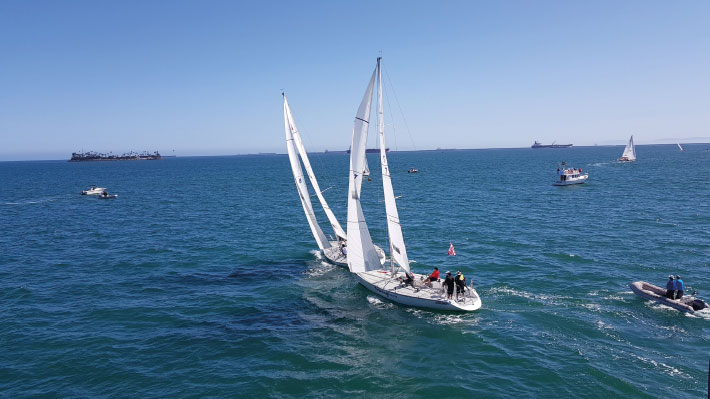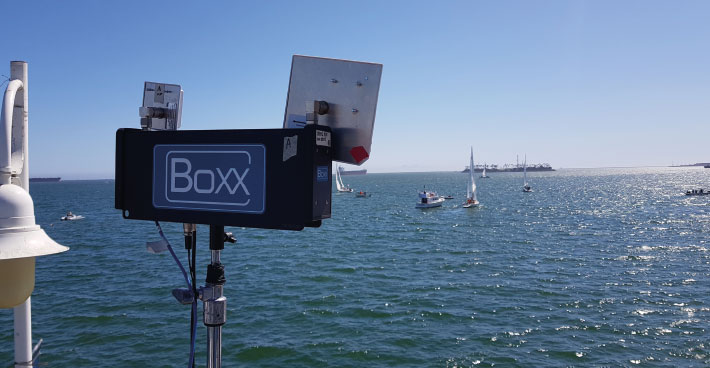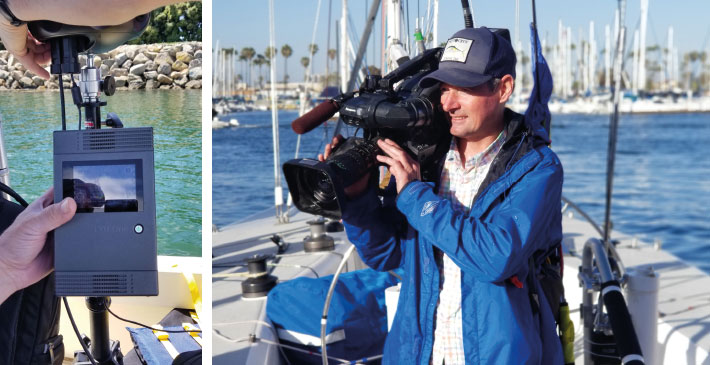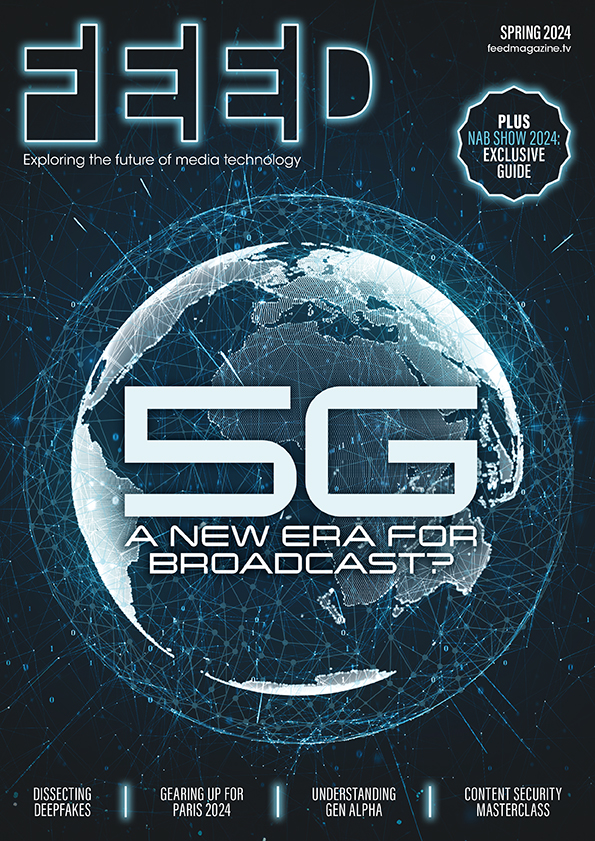VR is all at sea – but virtually under control

Posted on Jun 11, 2018 by PhilipStevens
The challenges of streaming VR from off the California coast
Known as “the grandfather of modern match racing”, the Congressional Cup attracts leading sailors from around the world. This year’s event, hosted by southern California’s Long Beach Yacht Club (LBYC), was the 54th anniversary of this ‘stadium regatta’. The event featured top-ranked skippers from as far away as the UK, New Zealand, Australia and Switzerland, as well as the US, competing for the coveted trophy.
Alongside the traditional broadcast coverage, it was decided to provide a unique perspective on this five-day challenging race through the use of 360° virtual reality cameras installed at strategic locations around the event – including the boats themselves. Organisers decided that immersive coverage would add substantial value to the coverage, especially for the devoted audience of sailing enthusiasts.
A number of companies were involved in the regular and immersive coverage, including TVU Networks, Samsung Electronics America, Telstra Broadcast Services, Boxx TV, broadcast integration and project manager Suitelife Systems and wireless innovation house Ocon Solutions Company (OSC).
“Integrating 360° footage requires an enormous amount of bandwidth”
Building enthusiasm
“We were excited to embrace the ground-breaking VR production values with our HD live-streaming production, knowing it would generate enthusiasm with younger viewers around the world,” explains Geoffrey Talbot, executive producer and chairman of the Long Beach Yacht Club Communications and Media Committee.
Talbot first became involved in the planning for this project in October 2017. “We believed that adding high-quality VR coverage and making that video accessible online would bring new generations to the sport. We needed to be able to transport all of this data-intensive video live and untethered.”
He reveals that the biggest challenge associated with the coverage was creating and maintaining wireless connections from the water back to shore. In all, 13 Samsung Round 360 cameras were deployed. One was used for streaming off the Long Beach Veterans Memorial Pier. A static camera was located on the MV Loynes, the LBYC Race Committee boat anchored at the Congressional Cup start/finish line, while a further camera was used to stream from a mobile power boat with TVU Networks’ aggregated cellular connectivity. “But for the most spectacular coverage we installed a total of ten static 360 cameras in LBYC Catalina 37 race boats,” states Talbot.
“Streaming from the cameras was achieved using Frontier’s FIO connection at the pier, up to Samsung VR in cloud. The workflow involved Samsung workflow blade servers on the pier.”
Switching between the VR sources took place on land near the LBYC pier, while further post production was performed at Samsung VR.
Bandwidth battle
Technical consultancy and support for the immersive coverage came from Ocon Solutions and its president, Jim Ocon. “Geoffrey Talbot called me because streaming has really come into its own in recent times and he was aware of the problems that can arise through the need for high bandwidth from, say, a sail boat to the pier. It sounds easy to do – and it is with traditional broadcast video, but harder to do when you have straight internet and need clean upload speed. And that applies whether it is a 360 camera or anything else.”
Ocon says that the major challenge was finding a clean pathway from ship to shore for the robust connection needed for Samsung’s VR cameras. “Each has 17 4K cameras on the device and it stitches the images together through a central processor. So, when we were looking at getting the images at 200-plus megapixels from ship to shore we knew it was going to be difficult to do.”
In light of those potential difficulties,
one suggestion was to carry out the stitching of the images together on board. As a result, a couple of the cameras were mounted on chase boats, all of which had power that could be utilised to drive the computer.
“As it was, we were still looking at having uploads of 50Mbps,” states Ocon. “We ended up using Statistical Inverse Multiplexing where we were aggregating four different carriers using the TVU networks router.”

“We needed to be able to transport all of this data-intensive video live and untethered”
Route to success
Two TVU Routers supplied the connection needed for the Round VR cameras to provide live distribution to the Samsung VR Video website and the Congressional Cup website. The coverage was also streamed to the Tribeca Film Festival’s website.
TVU Router uses multiple data communication links simultaneously, including cellular 4G/LTE, cable, DSL, satellite or WiFi, to deliver a reliable broadband connection up to 200Mbps remotely. TVU Router dynamically can aggregate up to a dozen different data connections and supports multiple 4G/LTE connections from different cellular providers.
Talbot was enthusiastic about the performance of the connectivity. “The VR wireless connectivity from the water back to the pier and the network streaming set-up performed flawlessly. Integrating 360° footage requires an enormous amount of bandwidth. We couldn’t have done it without the rock-solid connectivity of our TVU Router, which performed above and beyond expectations from stationary and moving boats.”
Paul Shen, CEO of TVU Networks, added, “The producers of this event are merging the best of technology with the best of sports to bring sailing to viewers in a way they’ve never seen it before. We couldn’t be happier to be part of such a forward-thinking production.”

Air, land and sea
On top of the VR cameras, there was traditional OB coverage that was streamed to Facebook and other platforms. This broadcast was handled by Los Angeles production company, Boxx Communications.
A total of eight cameras were utilised including four on the Yacht Club’s pier, two on a yacht, one on a follow boat and one on a drone. Wireless communications between the mobile cameras and the land used wireless RF links from Boxx TV wireless transmission solutions.
“Our technology allowed us to create a system that met the challenging budget for such an ambitious outside broadcast,” explains Scott Walker, co-founder of Boxx TV. “We specialise in solutions that are licensing exempt – but which meet the demanding needs of complex productions. Licensing-exempt frequencies can be challenging in built-up areas like downtown LA or somewhere like Times Square, but when we face the ocean there is little or no competition for frequencies.”
The Boxx equipment selected for the Congressional Cup centred on the company’s Zenith Low Latency Compressed HD transmission solution.
“The communication is bi-directional and that allows me from the land to configure and control the transmitter, which is either on the yacht or the follow boat,” explains Walker. “And that is a great benefit, because once the equipment is deployed on the boat, you cannot access it again during the day. As you go on during the day, there may be different levels of signal strength. The bi-directional aspect means I can go into Zenith and change the configurations, the modulation and the bandwidth to best suit the particular environment, even during a live transmission.”
The drone that Walker used was the DJI Mavic Pro which has a flight time nearly three times that of larger machines. “Because we were going so far out – probably a few miles – to follow the boats, we were able to stay in front of the boats for a lot longer. But to increase the time even more, we opted to put the drone operator on a boat rather than on land, and he would fly from that position and then microwave the pictures back to the OB truck.”
All in all, the coverage of this world-famous sailing event was deemed a huge success. As Talbot concludes, “The reaction to the 360° transmissions was fantastic.
VR immersion on race boats, amongst the crew and within the rigging, viewable 360° around, put a whole new dimension to sailing.”







